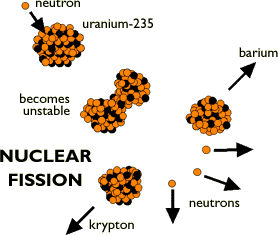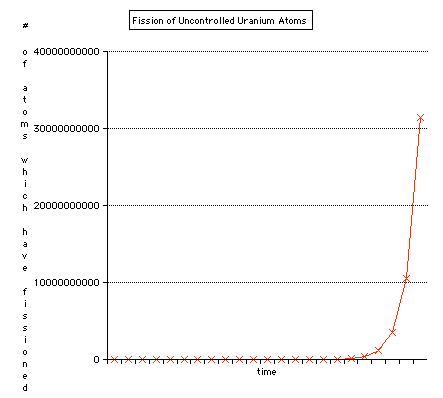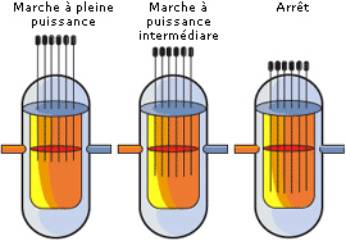Time Travel Research Center © 2005 Cetin BAL - GSM:+90 05366063183 - Turkey/Denizli
Nuclear Reactors
- All electricity is generated by spinning a big wheel that has
magnets near large coils of wire (or vice versa).

- Something has to be used to turn the turbine. Often steam is used as depicted above. Power plants that use coal, oil, or gas to generate electricity just use those fuels to heat water so that steam can turn a turbine. In nuclear power plants, the heat generated by fissioning Uranium or Plutonium boils water which creates the steam needed to rotate the turbines.
- Recall the previous illustration of the fissioning of Uranium:

(Used with permission. Original found at: http://www.sciencenet.org.uk/database/Physics/Atomic/p00435c.html)
- Notice that for every one uranium atom that splits three neutrons are
produced (along with some energy). If every neutron causes another atom to
fission the amount of energy released would soon grow out of control (what
happens in a nuclear explosion). The graph below shows how quickly the
number of atoms splitting would grow if unchecked.
# of atoms which have split
 1
1
3
9
27
81
243
729
2187
6561
19683
59049
177147
531441
1594323
4782969
14348907
43046721
129140163
387420489
1162261467
3486784401
10460353203
31381059609
- So, some of the neutrons which are emitted must be absorbed before they can cause another uranium atom to fission. Control rods are inserted between rods of uranium fuel. These rods capture some of the neutrons and prevent the fission reaction from going out of control.
- Below is an image of the type of reactors common in the US:



- Safety Issues
- There are several different designs for nuclear power plants. The variations are mostly in what material surrounds the nuclear fuel and how the fuel is packaged.
- Most of the nuclear power plants in use today in the US are of the design depicted above. These plants are very old and no new plants have been constructed since the early seventies. This is primarily due to the safety concerns people have had regarding a major catastrophe at one of the plants.
- If for some reason the fission reaction goes out of control, it is possible to have a large release of radioactive material. It is impossible to have a nuclear explosion like that of an atomic bomb, but a major accident at a nuclear power plant would be devastating to the surrounding area. Fortunately, there are MANY safety systems and backups for the backup systems to prevent this. The only major release of radiation occurred in 1986, at the Chernobyl nuclear power plant in Kiev (the former Soviet Union). And this happened only because the people operating the plant disregarded virtually every safety regulation and disconnected the safety systems to run a test. Even the design of the plant is much more dangerous than any power plant in operation here in the US.
- Some people fear that just living near a nuclear power plant can expose them or their children to high amounts of radiation, but this is not true. Living right next to a power plant would add only about 1 mrem (of the 360 mrem present in the normal background radiation) per year of radiation.
- Today there are plant designs that are inherently much safer than those already in operation. However, concern over the dangers of nuclear power have prevented any of these plants from being built.
- Waste disposal issues
- Many proponents of nuclear power say that it is "clean" power. What they mean is that the air pollution caused by the burning of coal, oil, or gas, is not created in nuclear power plants.
- While this is true, the main environmental issue with nuclear power plants is the highly radioactive waste they produce. To date, we still have no solution as to how this waste can be safely stored. Currently, all the nuclear waste that is produced is kept in relatively unsecured storage facilities at the power plant. They have no place to put it.
- Several of the isotopes present in the waste have very long half-lives requiring that the waste be stored for 10,000 - 100,000 years before they have decayed to a safer low level.
- The only real option being considered today is underground storage of the waste under Yucca mountain in Nevada. After decades of study, there is still controversy over whether this site is suitable to safely contain the nuclear waste over the time periods necessary.
Hiçbir yazı/ resim izinsiz olarak kullanılamaz!! Telif hakları uyarınca bu bir suçtur..! Tüm hakları Çetin BAL' a aittir. Kaynak gösterilmek şartıyla siteden alıntı yapılabilir.
The Time Machine Project © 2005 Cetin BAL - GSM:+90 05366063183 -Turkiye/Denizli
Ana Sayfa /İndex /Roket bilimi /
 E-Mail /CetinBAL /Quantum Teleportation-2
E-Mail /CetinBAL /Quantum Teleportation-2
Time Travel Technology /Ziyaretçi Defteri / Duyuru / UFO Technology